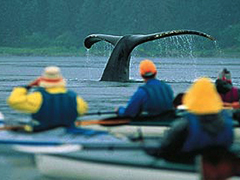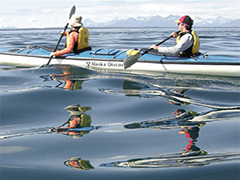|
Glacier Bay National Park was completely covered by ice just 200 years ago. Explorer Captain George Vancouver found Icy Strait choked with ice in 1794. The “Y” shaped body of Glacier Bay includes 16 tidewater glaciers. 12 of them are active and calve icebergs thundering into the bay. On the east and west of the 65 mile long bay the steep mountain summits of the Chilkat and the Fairweather Ranges rise up to provide a dramatic backdrop of glaciated mountain tops. During the summertime hundreds of whales are staying in Glacier Bay to feed in the nutrient rich waters before migrating back to Hawaii.
|
|
Q:
A: |
How do I get to Glacier Bay?
Glacier Bay National Park is located at the northern end of Southeast Alaska’s panhandle - approximately 50 miles west of Juneau. The only way to get to the Park is by charter or commercial aircraft and by boat. Daily air service to Gustavus is available between June and September from Juneau, Haines and Skagway, (flight time appr. 30 minutes) A high-speed passenger catamaran operates between Juneau’s Auke Bay and Gustavus / Bartlett Cove. There are no roads to and within Glacier Bay National Park and limited Alaska Marine Highway Ferry services. Please Note: You will not see any icebergs from the Bartlett Cove area. The only access to the fjords and bays within the national park is via a tour boat. |
|
|
Q:
A: |
How can I visit the National Park?
Due to it's vast size and remote nature, the best ways to visit Glacier Bay National Park or Icy Straits is by tour boat, cruise ship or individually/escorted with kayak excursions. We offer a variety of 1-3 day tours, sightseeing and soft adventure programs. Custom itineraries are available upon request. |
|
|
Q:
A: |
When is the best time to visit the Park?
In May wildlife is easy to spot. Migratory birds are resting on the way to the south. Spring on the average has less rain than fall and there are fewer visitors in the Bay! In June throughout the area bears are easily spotted on shore and in mid June the whales are returning to Glacier Bay. July and August are the most popular months. The whales are here, breaching, playing and feeding. Flowers are in full bloom. In September fewer visitors are in park. The bears are fishing for salmon! Great for glaciers! Good time to see the Northern Lights. The birds are migrating north for good bird watching. |
|
|
Q:
A: |
What will I see in Glacier Bay?
Visitors will encounter icebergs, wildlife, and majestic country unrivaled by any other park in Alaska. The Glacier Bay National Park area includes 16 tidewater glaciers of whom 12 actively “calving” icebergs into the bay. The show can be spectacular. As water undermines the ice fronts, great chunks of ice - up to 200 feet high - break loose and crash into the water. The Johns Hopkins Glacier calves such volumes of ice that it is seldom possible to approach its ice cliffs closer than about 2 miles. Access to the fjords and bays is by tour boat leaving Bartlett Cove daily at 8:00 am / returning 3:30 pm. An onboard lunch is included. |
|
|
Q:
A: |
Will I see wildlife?
Glacier Bay is home to a variety of wildlife. Humpback Whales, Orcas, Seals, Sea Lions, Sea Otters, Porpoises and numerous species of Sea Birds are just some of the varied marine creatures visitors can witness. In addition to the marine creatures, other commonly seen animals are mammals such as Brown and Black Bears and Moose. More than 200 species of birds found in the park include: Bald Eagle, Golden Eagle, Raven, Owl, Sandhill Crane, Loon, Stellar Jay, Murre, Cormorant, Puffin and many others. |
|
|
Q:
A: |
Are any hotels directly in the Park?
Only a very limited number of remote wilderness lodges are operating within the park area with a government license. Additional accommodation is available in Gustavus – about 6 Miles by road from Bartlett Cove. A government campground is located on the shores of Bartlett Cove. For accommodation details lease refer to our Glacier Bay tour pages. |
|
|
Q:
A: |
What is the weather like?
Summer daytime temperatures range from 45° to 65° F. Periods of rainy, cool and overcast weather is common in Southeast Alaska. The weather almanac indicated an average 153 rainy days per year with an annual rainfall of 71 inches. A sweater, hat, gloves and rain gear are recommended. Glacier Bay receives 18 1/2 hours of sunlight during the summer solstice. |
|
|
Q:
A: |
What's about Outdoor Activities?
There are a number of outfitters and soft-adventure companies operating from Juneau and Gustavus. Some of the available activities include: flight-seeing adventures, day and overnight kayak touring, whale watching, sport fishing, photography and hiking. For additional information please refer to our tour pages. |
|



